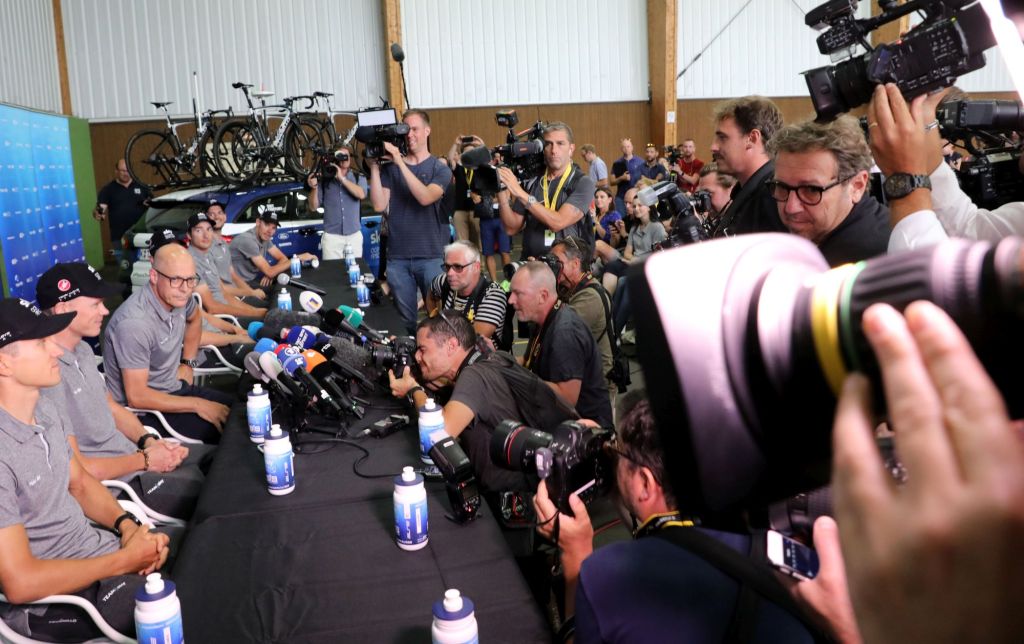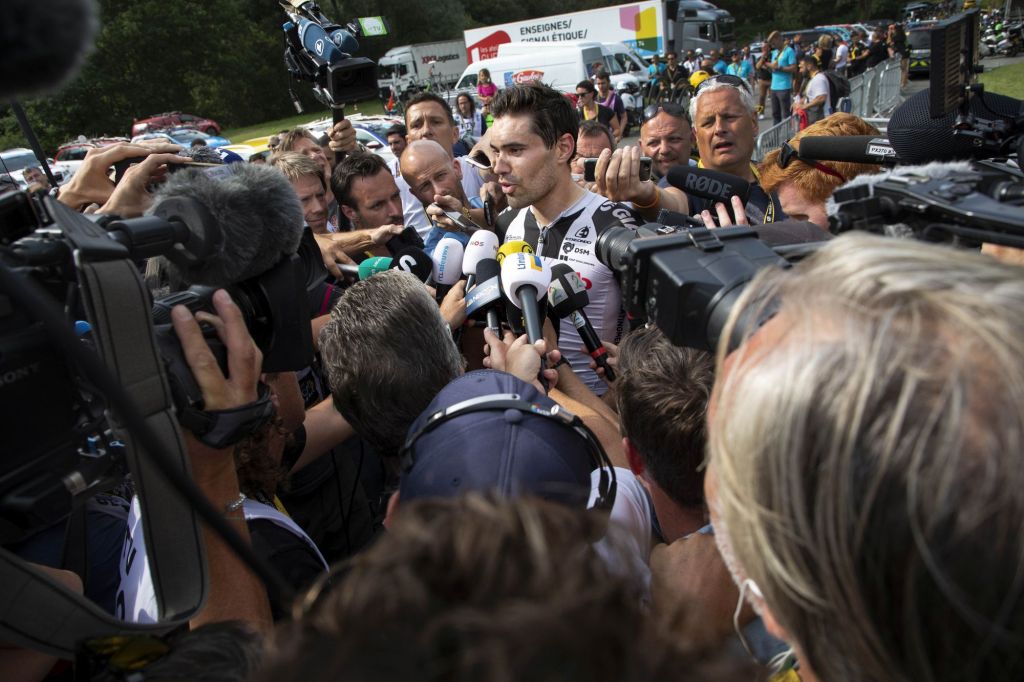
Steve Maxwell is Co-Editor of The Outer Line – “The External Perspective on Pro Cycling” and a part-owner of Pocket Outdoor Media, the parent company of VeloNews. He is a business consultant and transactional advisor based in Boulder, Colorado.
Three years ago, Felix Magowan and I wrote a commentary about on-going consolidation trends in the broader bicycle industry. When growth is slow and too many companies are competing to provide similar services, that’s what naturally happens – down-sizing on the supply side of the market and consolidation amongst the remaining players. Many other sectors of the bike industry have unfortunately been in this kind of predicament for several years now, so it’s no surprise that the media sector is experiencing similar symptoms. There are simply too many players providing similar services to a small – some would say even shrinking – market.

This challenge is amplified by transformative changes that we’ve all heard about in the broader media industry – the “death” of print, the shift to digital, the focus on “click bait,” the rise of social media as a primary purveyor of news and opinion, seemingly ever shorter attention spans and so on. The way in which news is gathered, reported, and distributed is changing dramatically, and it has created blistering economic pressures on media platforms across all industries. Even flagship icons like the New York Times have seen their revenues essentially halved over the last decade, while the McClatchy group’s sales have fallen by almost two-thirds. Indeed, the journalism profession itself is in steep decline, with the workforce in the U.S. having been cut in half during the last 15 years; more journalists have lost their jobs than coal miners.
There are perhaps some fifty or so significant cycling media entities (CMEs) serving different sectors and regions of the international cycling industry – websites, print magazines, podcasts, video producers, independent bloggers and so on. There are also several “labor of love” CMEs – niche websites/blogs driven solely by their passion for the sport. These CMEs compete vigorously against each other, but from a broader perspective they’re all in the same industry “boat.” Thus it seems worthwhile to objectively evaluate the on-going changes in competitive landscape, and try to better understand the drivers of future success.
Perhaps most importantly, an understanding of these trends, and their underlying drivers, is critical for the ultimate customers in this industry – the readers. It is vital that readers comprehend the challenges faced by CMEs – that they, as consumers, recognize they may also need to change and adapt if they wish to continue consuming good editorial content. This article summarizes the current situation and possible future directions for the cycling media business.
How Did We Get Here? Most CMEs describe themselves as “for-profit” businesses, but since virtually all are players in the business are privately-owned, comparative financial data are scarce. While there are exceptions, it is likely that many CMEs are not actually currently profitable. This assumption is borne out by a number of recent down-sizing or consolidation events:
- The shuttering of print magazines like RIDE Cycling Review, Cycling Active and CycleSport
- The shrinkage or disappearance of various digital media platforms, like the recent closure of BikeRadar’s U.S. operations. (And even much larger mainstream print sports publications like ESPN The Magazine are being shuttered.)
- The loss of quality journalists to advertisers or teams, or to other industries altogether – note the case of former VeloNews writer Matt Beaudin, now with Team EF, or long-time Sports Illustrated cycling writer Austin Murphy, who worked as an Amazon delivery truck driver after he was cut loose from SI, and now reports for a local California newspaper.
- And most significantly, recently ramped-up consolidation activities between competitors – for example, Discovery’s purchase of EuroSport and follow-on investment in Shift Active Media and GCN; the acquisition of Competitor Group endurance sports brands – including VeloNews – by Pocket Outdoor Media, and its recent deal with Bicycle Retailer and Industry News (BRAIN); the purchase of CyclingTips by PinkBike; and the reacquisition of CyclingNews and Pro Cycling magazine by Future Media.
How did this challenging situation come about? In addition to the broader media trends mentioned above, CMEs are wrestling with several additional industry-specific challenges:
- As traditional print has declined, few CMEs have yet been able to successfully establish a significant paywall for their emerging digital product.
- Advertisers have shifted away from print and toward digital. But with Google and Facebook already controlling a large share of digital advertising, an appreciable fraction of historical advertising revenues are being irreversibly lost to the CMEs.
- For years, advertisers have also been gradually increasing their use of third-party PR firms or setting up their own internal marketing and social media capabilities – going straight to their customers, bypassing the need for traditional media altogether.
- Due to these pressures, CMEs have naturally tended to become more deferential toward (cynics might say more controlled by) their remaining advertisers. While this tendency has always been there, it has recently become more overt. As a result, the independence and objectivity of editorial content – particularly product review and technology coverage – may have suffered.
- At the same time, the primary subjects covered by the media – teams, athletes and events – have increasingly internalized their own branding and messaging, making access more difficult for journalists. And once they do obtain access, journalists understand that if they rock the boat, they probably won’t be invited back. Indeed, with the increasing influence of social media, it sometimes seems like cycling journalists are in outright competition with the very people or entities they are trying to cover. These considerations affect the objectivity and quality of editorial content on both sides of the coin – that produced by the athletes or teams themselves, as well as that produced by professional journalists.

The Current Challenge: All of these trends tend to interact and reinforce each other. As print subscription and advertising revenues decline, budgets must be tightened, and editorial content may start to suffer. As content quality declines, fewer people subscribe; as fewer people subscribe, advertisers retreat further, causing additional economic stress. With increasingly bare-bones budgets, editorial talent or free-lance writers may start to exit the industry. And so on. On bad days, it can seem like a race to the bottom. A new model is clearly needed.
And CMEs have a tougher challenge in this regard than many other industries – simply due to the effect of scale. Cycling just isn’t a very big market. When one takes into account language and cultural differences within the broad audience, specific addressable markets may be even smaller. The New York Times may face many of these same systemic problems, but it has an audience of millions of potential subscribers. The same can unfortunately not be said for even the largest CMEs.
Finally, making the situation even tougher are the various structural and economic challenges which the sport itself faces – uncertain sponsorship dollars, the lack of easily accessible television coverage, continued doping and reputational concerns, declining audiences, the scarcity of new break-out stars and the absence of a sustainable economic model. And the situation in women’s cycling is even worse.
Individual CMEs are not going to stand in the face of these changes. If they want to survive, CMEs need to better understand and rapidly adapt to the sea change now underway in the industry. One way to look at the basic challenge is this: for quality journalism to be sustained, someone has to pay for it – and that has be either the consumer, the advertiser, or the producer. Historically, cycling media content producers have been financially supported by the consumer (reader) through subscription fees, and the advertiser, through paid ads. But with declining advertising, and with much of the content now freely available on the internet, both revenue sources have declined.
With both of the traditional sources of revenue declining, the cost of providing content seems – at least at this moment in time – to be disproportionately falling on the shoulders of the only other party left at the table – the producer, the CME itself. In other words, many CMEs are effectively covering the difference by paying for the content themselves, burning through cash to keep their operations alive. They find themselves effectively gambling that the current situation is going to somehow stabilize, that people will soon start paying more for internet content – that the current shakeout will soon be over. But these things don’t seem likely to happen in the near future. Cycling is famous for its wealthy patrons, but such investors on the media side will eventually run out of patience – purely philanthropic producer-financed content is not a sustainable model either. Something has to give.
From the individual CME perspective, it seems that future survival reduces down to four critical factors:
- Can we make our content unique and high-quality enough that we become “necessary” or “indispensable” for a certain audience?
- Can we present a significant enough value proposition that our audience is willing to pay for that content?
- Can we then create a large enough audience to be able to attract and monetize the interest of advertisers? and,
- Does that create a large enough financial base for our survival or profitability?

What Can CMEs Do? There are several key strategies and tactics which economically-challenged CMEs should undertake:
- First – from a more day-to-day “blocking and tackling” perspective – it seems obvious that CMEs have to quickly double down on all the standard and classic business strategies employed for survival in highly competitive industries – cross-training staff, exiting less profitable businesses, out-sourcing tasks that can be more efficiently done by others, cross-selling, examining other revenue sources (like newsletters, events, affiliate income streams, etc.) – generally doing more with less.
- CMEs should conduct a frank and critical self-analysis – what are they really good at, and what are they not so good at. Small organizations with limited financial resources in highly competitive markets need to focus on doing what they do best. Too many CMEs today exhibit a “herd mentality” – all frantically racing to do the same thing their competitors are doing – running the same types of articles, seeing who can post news service stories the fastest, starting up a podcast in response to other sites starting podcasts, and so on.
- Quit trying to do what everyone else is already doing – do something different! Cover some different topics! When you have limited resources, why spend them doing what everyone else is already doing? (For example, a 2011 survey found that 78% of all sports journalism is essentially about games and athletes; only 2.7% of articles covered sports politics, and only 3.1% discussed economic aspects of sports.)
- “Sponsored content,” brand partnerships or paid editorial content is increasingly common, though some CME’s provide it in a more shadowy or disguised manner than others. CMEs need to establish a clear strategy and marketing approach for paid content.
- Most CMEs need to better understand what their audience really wants. How many actually and formally survey their key audience? An emerging guideline in digital media focuses is the 7% rule-of-thumb – that small number of readers (typically somewhere between 2% and 12% of total web visitors) who drive more than 50% of the traffic and revenue on the site. CMEs need to hone in on their “seven-percenter” audience and focus on what they are interested in reading and buying. Understanding and converting this diehard audience will go a long way towards determining whether you’re still in business five years from now.
- From more of a strategic perspective, CMEs should step back and better define their real mission. While it may sound simple, the real question that CMEs must ask themselves is this: what is our real product, and who is our real customer? There are two quite different answers to this question:
1. Our product is good journalistic and editorial content, which we provide to our customers – the readers; or
2. Our product is our readers, the “eyeballs” which we provide to our real customers – the advertisers Put more bluntly, is the CME’s primary focus on its readers, or on its advertisers? - Obviously, every CME has to strike some balance between these two competing objectives, but the way you intuitively answer this question provides a lot of direction about how you should run your business and focus your priorities.
The good news is, there are some emerging examples of mainstream media firms reinventing themselves and turning around their economic model, and there are anecdotes about successful CMEs, being run on tight budgets and small staffs – right-sized to economically cater to their specific audience.

The Future: Several broad realities seem clear about the future of cycling media. The consolidation process will certainly continue; all CMEs will have to continue evaluating whether it makes more sense to band together with another party, rather than fighting it out. To date, no significant player has emerged with sufficient capital or the strategic commitment to play the role of a true industry consolidator. But that opportunity remains – to combine some of the strongest CMEs, removing redundant costs, retaining the best journalistic talent, providing a stronger offering of content for readers and a more attractive vehicle for advertisers.
Because the internet has reduced distribution costs almost to zero, the future will increasingly belong to those that can focus in on niche areas for a specific audience. As one media newsletter recently put it, “Success used to come from being broad-based with a geographic monopoly….. On the internet, though, success comes from being narrow while reaching the whole world. It is the exact opposite.” In other words, someone in Timbuktu can now subscribe to your cycling site just as easily as someone in New York City; CMEs need to exploit this advance in terms of building on their strengths, specializing their content and marketing it to the right audience.
The good news for CMEs is that there is still an audience out there – pro cycling aficionados who want to continue consuming interesting news and content about their sport. It may not be a huge audience, but it is still there and it still demands to be served. And those consumers will increasingly recognize that they must play a different role in this evolving industry as well. The internet has changed a lot of things, but it hasn’t made good journalism free. The old models are rapidly changing, and readers must be willing to shoulder their share of the expense of creating that good journalistic content that they want to consume. Readers must be willing to replace their old magazine subscription fee with a new paywall fee, or with some form of on-going donations to help pay for and sustain that good journalism.
This is starting to happen, but it will still take time for both producers and consumers to adjust to the new models. This is an evolutionary process, and there will undoubtedly be more bumps in the road. Not all CMEs will survive this transition. But it’s important to remember that it was the media business – in the form of the French and Italian newspapers – that helped to bring about and define the sport of pro cycling in the early 20th century. It is the media that has sustained and helped to popularize the sport for many years – and there will still be a critical role and need for a new and reinvented cycling media in the future. Readers must better understand and support the changing dynamics of the industry, and CMEs must adapt and innovate to deliver quality and specialized content in an economically sustainable manner. For those more agile, innovative and daring players, there will be opportunities to survive, perhaps even thrive, in the cycling media world of the future.
(This article appeared previously on Bicycle Retailer and Industry News. The author would like to acknowledge critical input and suggestions from the following individuals: Rob Arnold, Luke Beatty, Lionel Birnie, Ted Costantino, Stephen Farrand, Bonnie Ford, Joe Harris, Mark Johnson, Raymond Kerckhoffs, Joe Lindsey, Richard Moore, and Brad Roe.)

